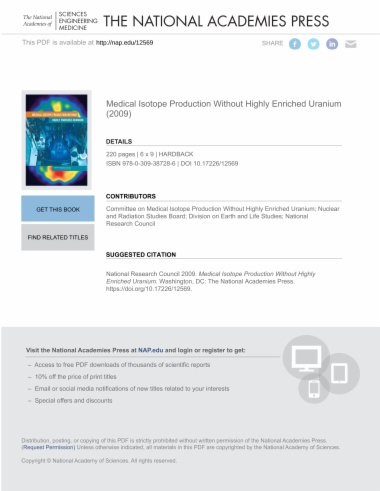This book is the product of a congressionally mandated study to examine the feasibility of eliminating the use of highly enriched uranium (HEU2) in reactor fuel, reactor targets, and medical isotope production facilities. The book focuses primarily on the use of HEU for the production of the medical isotope molybdenum-99 (Mo-99), whose decay product, technetium-99m3 (Tc-99m), is used in the majority of medical diagnostic imaging procedures in the United States, and secondarily on the use of HEU for research and test reactor fuel.
The supply of Mo-99 in the U.S. is likely to be unreliable until newer production sources come online. The reliability of the current supply system is an important medical isotope concern; this book concludes that achieving a cost difference of less than 10 percent in facilities that will need to convert from HEU- to LEU-based Mo-99 production is much less important than is reliability of supply.
- Cover
- Front Matter
- Summary
- 1 Background and Study Task
- 2 Molybdenum-99/Technetium-99m Production and Use
- 3 Molybdenum-99/Technetium-99m Supply
- 4 Molybdenum-99/Technetium-99m Supply Reliability
- 5 Molybdenum-99/Technetium-99m Demand
- 6 Molybdenum-99/Technetium-99m Production Costs
- 7 Conversion to LEU-Based Production of Molybdenum-99: Technical Considerations
- 8 Conversion to LEU-Based Production of Molybdenum-99: Regulatory Considerations
- 9 Conversion to LEU-Based Production of Molybdenum-99: General Approaches and Timing
- 10 Conversion to LEU-Based Production of Molybdenum-99: Prospects and Feasibility
- 11 Progress in Eliminating HEU Use
- References
- Appendix A: Section 630 of the Energy Policy Act of 2005
- Appendix B: Biographical Sketches of Committee Members
- Appendix C: Presentations and Visits
- Appendix D: Alternative Molybdenum-99 Production Processes
- Appendix E: Correspondence with Atomic Energy of Canada Limited
- Appendix F: Present Value Calculation
- Appendix G: Glossary
- Appendix H: Acronyms

